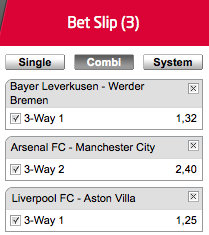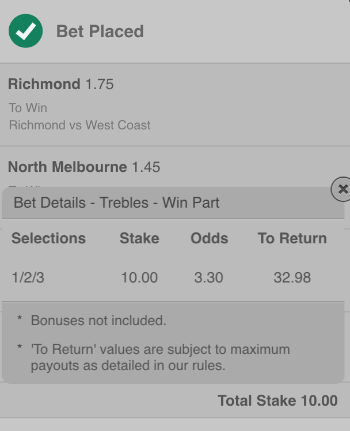Multi Bet Trebles
.
One of the common questions I invariably get asked when discussing my job is ‘What’s your biggest winning bet’?
Usually, I struggle to recall a huge winning bet as most of my winners come at ‘normal’ prices but this week I picked up a 77/1 winning bet (more about this later on) which has inspired my column today.
With a multi bet the odds equal the product of the individual odds. Here the multi bet odds equal (2.02. 1.60. 1.92) = 6.205. Suppose you placed $30 on this multi bet and all three selections won.
This big winner was based on a simple ‘multiple’ betting strategy I have adopted for some-time and one which I feel many other punters might also benefit from. Allow me to explain…
- Multiple Bet (or Multiples, Accumulator, ACCA etc) is simply more than 2 single bets are combined as a single bet. Each linked event is called Leg, so the first bet is Leg 1, the 2 nd is Leg 2 etc. Double is a bet.
- A win football accumulator is a bet that contains 4 or more selections whereby every selection must win for the bet to be successful. The main advantage of a win accumulator is that the odds and winnings can be much higher than singles or trebles making it more tempting but coming at a greater risk.We provide daily football accumulator tips with selections coming from all of your favourite.
Comparing Single & Double Bet Value
Firstly, I want to set the scene with some mythical fixtures and prices to compare the profits from both single and double bets.
For ease of explanation, let’s imagine that this weekend my beloved Everton are priced at evens (2.0) to beat Man Utd and Leicester are also evens (2.0) to beat Southampton. Effectively they are 50/50 shots.
Therefore, if you are able to get anything above 2.0 (evens) on those matches, then you’ve got a value bet and should make a profit in theory.
A quick check at the fictional odds available at the bookies shows that both Everton and Leicester are available at around 2.20 (6/5).
My options if I wanted to back both are as follows:
- 2 Single Bets: Back Everton & Leicester at 2.20 as 2 single bets. Potential profit if both win: 2.40 points.
- 1 Double Bet: Back Everton & Leicester at 2.20 as 1 double bet. Potential profit if both win: 3.84 points

As you can see the double bets will ultimately provide the greatest profit and long-term a 21% Return on Investment. This compares well with the 10% Return on Investment to be had simply backing single bets.

The main difference here comes in the strike-rate as the double bet will only win 1 in 4 times, compared to the 1 in 2 strike-rate the single bets have.
Ultimately it’s this strike-rate for success (50% for single bets vs. 25% double bets) that can make all the difference and really test your patience when doubling up.
The question to ask is if you’re willing to accept the risk of taking a longer losing run in exchange for higher profits?
Treble & Trixies
Whilst I draw the line at placing big accumulators I am also a fan of placing Treble bets or Trixie bets when you have 3 value selections.
It might be unlikely for a 10-fold accumulator to come in, yet it is more than reasonable to expect 3 bets to win or place (if placing an each way treble) every now and then.
For those of you looking to be even more creative, if you have 3 value tips, you might like to try a Trixie bet, which is actually 4 bets in 1: 3 doubles and 1 treble.
You needn’t risk huge stakes on such bets, but they are a nice way to compliment single bets you place and can often pay out big on the occasions they come in.
Which leads me back to my bet earlier this week, where one of my regular trixies came in at decent odds. I placed a £1.25 each way Trixie on 3 horses at 7/1, 9/2 & 4/1, which all duly came in. Thus my £10 staked became £778.20. Click here to see my betslip
Admittedly I got a little lucky as my 7/1 winner was uplifted to 14/1 – but even if paid out at the lower odds, it more than made up for any losses incurred by past losing trixies. As I usually bet them each way, very often I get a few place and wins to make a few quid back and tick me over until these big wins come in!
Bad Single Bets = Bad Multiple Bets
Before you rush off to place a whole series of multiple bets – it’s important to make clear that Doubles, Trebles & Trixies betting is only as good as the bets you are placing or the tipsters you are following who advise the tips.
If your bets don’t make a profit as a single, they won’t magically make a profit when bet as a multiple.
Many mug punters roll up short priced football bets in an attempt to push up their returns with no concept of value. This is why bookmakers sometimes love you betting on doubles and trebles – If not used correctly, they can multiply your losses as well as profits.
My own Trixie selections on the above winning bet were based on tips put forward by some of the high quality tipsters we work with here at the Smart Betting Club.
With access to a number of these tipsters, alongside placing all the single bets they put forward, it’s also sometimes worth the occasional multiple bet when the odds remain in your favour.
For those of you with the patience and foresight to ride the losses in anticipation of the winners when they come, it can add another string to your betting bow.
I do hope you have enjoyed my article today – hopefully its provided some food for thought and options for your betting moving forward.
Multiple betting is a betting type that allows punters to place a series of bets on one betting slip. There are a few different forms of multiple (more on the later) but the simplest is the humble accumulator or acca. For an accumulator bet to be successful, all the results must come in – if even one bet fails to win then the whole bet will have lost and you will have lost your stake.
The reason multiple betting is so popular is that it allows punters to get a greater return from a series of results rather than just taking a low odds bet on a single result. For example, rather than placing three bets at evens you place one three-fold accumulator that has odds of 7/1.
The amount of bets you can have a multiple are pretty much unlimited. The more bets you include the higher the odds are going to be, but also the less likely the bet will turn out to be a winner. Multiples can include as little as two different bets (double) and stretch to as many as 15 or even more. Three bets for your multiple are known as a treble, whilst four or more bets are simply known as an accumulator. Bets may also be known as folds; so 5 bets maybe known as a 5 fold , 6 bets 6 fold and so on.
How do Multiple Bets Work?
To give you a better understanding of a multiple bet we will run through a quick working example.
First off let’s look at how the maths of a multiple bet works. For each bet a point is added to the odds. Our first bet is 3/1 and our second bet is 5/1. To work out our double simply add one point to each value and then times the two values. So we now get 4 (3/1 + 1 point) times 6 (5/1 +1) to equal 24, which is a 23/1 double.
If you are using decimals instead of fractions then simply times the two numbers together for a double. So a double of 2.00 and 4.00 would equal a multiple of 8.00 (2.00 x 4.00). Note: Decimals are a much simpler way to work out your accumulator bets.
When you are adding more than two bets simply times together the decimals off the odds. If we had a 5 fold accumulator with bets of 3.40, 1.66, 2.10, 2.5 and 2.20 then after we multiple these numbers together we would get odds of 65.18.
Obviously the odds of each individual bet will have an effect on the overall accumulator odds with the higher the odds the greater the accumulator bet will become.
Whats The Different Between a Multiple and an Accumulator?
We’ve already introduced the concept of an accumulator as a multiple bet and many people use the terms interchangeably. Our American friends also have another word for this type of bet, calling it a ‘Parlay’.
Technically speaking though we prefer to view an accumulator as a type of multiple bet rather than being one and the same. The reason for this is that as well as accumulators there are other forms of multiple bet you can place. For example, a ‘Lucky 15’ involves a series of overlapping accumulators placed on the same group of bets. The idea here being that you don’t need all of your legs to win, but you still have the opportunity for a larger payday than if you have placed your bets individually.
Types of Multiple Bets
There are many types of multiple bets on offer from a host of bookmakers. Let’s look at some of the more common ones.
- Double – A multiple which consists of 2 different bets
- Treble – A multiple that consists of 3 different bets
- Accumulator – A multiple that consists of four or more bets. These may also be known as 4 fold, 5 fold, 6 fold etc depending on how many bets are in the accumulator.
- Trixie – A Trixie is wager placed on three selections of four bets. These must include 3 doubles and a treble. To gain a pay-out from this bet two or more selections must be successful.
- Yankee – A Yankee is 11 bets but based on four separate selections. These must include 6 doubles, 4 trebles and a 4 fold accumulator. For a pay-out from a Yankee you must get at least selections correct.
- Lucky 15 – Popular with horse racing fans, a lucky 15 is the same as a Yankee but also includes single bets. So as well as the 6 doubles, 4 trebles and four-fold acca, you also have four single bets.
The last three types of bet are what’s known as a ‘Full Cover Bet’. This is the other category of multiple that we spoke of earlier in the article and one that we’ll cover in more detail in the next section.
Full Cover Bets
Unlike a straight accumulator which has only two possible outcomes – win or lose – a full cover bet pays out even if only a few of your selections win. The reason for this is that instead of placing one bet covering all selections to win, you place a series of smaller bets that between them cover all of the possible accumulator outcomes you could have placed on those bets – hence the name “full cover”.
The simplest full cover bet is a Trixie which involves three selections. Let’s call them Horse A, Horse B and Horse C. If you place a Trixie on these three horses you would actually be placing four bets – one three leg accumulator on all three horses to win PLUS three doubles on Horses A + B, A + C and B + C.
Because you have three doubles covering all possible combinations you only need two out of the three horses to win to get some kind of return. For example, if Horse A and Horse C won but Horse B lost you would lose your three fold accumulator as well as the two doubles involving Horse B, but you would win the double that included Horses A + C.
The return you would get from two horses winning would be less than if all three had won, but more than had you only placed a straight up accumulator on the selections.
If you wanted to include four selections this would be called a Yankee and involves 11 bets. One four fold, four trebles and six doubles.
You can see a list of the different kinds of full cover bets in the table below:
Trebles Multi Bet
| Bet | Selections | Number of Bets | Bet Distribution |
|---|---|---|---|
| Trixie | 3 | 4 | 3 doubles + 1 treble |
| Yankee | 4 | 11 | 6 doubles, 4 trebles + 1 four fold |
| Super Yankee | 5 | 26 | 10 doubles, 10 trebles, 5 four folds + 1 five fold |
| Heinz | 6 | 57 | 15 doubles, 20 trebles, 15 four folds, 6 five folds + 1 six fold |
| Super Heinz | 7 | 120 | 25 doubles, 35 trebles, 35 four folds, 21 five folds, 7 six folds + 1 seven fold |
| Goliath | 8 | 247 | 28 doubles, 56 trebles, 70 four folds, 56 five folds, 28 six folds, 8 seven folds + 1 eight fold |
Full Cover Bets With Singles
A full cover bet with singles is exactly as it sounds – the same as the type of bets mentioned above but also including single bets on each selection. Here you only need one bet to win to get some kind of return, although depending on the odds the return is often less than the cost of the bet.
A Trixie with singles is called a Patent and involves 7 bets over three selections:
- 3 singles
- 3 doubles
- 1 treble
A Yankee with singles is called a Lucky 15 and includes 15 bets over four selections:

- 4 singles
- 6 doubles
- 4 trebles
- 1 four fold

A full list of full cover bets with singles can be found in the table below:
| Bet | Selections | Number of Bets | Bet Distribution |
|---|---|---|---|
| Patent | 3 | 4 | 3 singles, 3 doubles + 1 treble |
| Lucky 15 | 4 | 11 | 4 singles, 6 doubles, 4 trebles + 1 four fold |
| Lucky 31 | 5 | 26 | 5 singles, 10 doubles, 10 trebles, 5 four folds + 1 five fold |
| Lucky 63 | 6 | 57 | 6 singles, 15 doubles, 20 trebles, 15 four folds, 6 five folds + 1 six fold |
Pros & Cons of Multiple Betting
Benefits
Multiple betting is a great way to increase the odds on a host of short priced favourites for any market. You can mix and match sports, include games on different days and basically add short priced favourites to bolster the overall pay-outs.
Sticking with pay-outs, multiple betting is probably the most lucrative type of betting. The pay days can be huge for very little outlay. Just from taking the 5 fold above in our example you will see that a bet of just 1 unit would yield a 65.18 unit return.
Multibet Trebles

Multiple Treble Bet Calculator
Disadvantages
Multiple betting is actually very high risk, especially with the more bets you keep adding to the list. Only one of those bets needs to be unsuccessful for the whole of the multiple bet to be written off as lost. Many bettors get carried away with the possible big payday when actually it’s very hard to string together 4, 5 or more consecutive correct results.